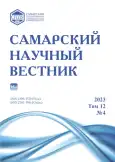Some results of the introduction study of Leonurus cardiaca plants in the middle taiga subzone of the Komi Republic
- Authors: Portnyagina N.V.1, Echishvili E.E.1
-
Affiliations:
- Institute of Biology of Komi Scientific Centre of the Ural Branch of the Russian Academy of Sciences
- Issue: Vol 12, No 4 (2023)
- Pages: 87-92
- Section: Biological Sciences
- URL: https://journals.rcsi.science/2309-4370/article/view/260640
- DOI: https://doi.org/10.55355/snv2023124113
- ID: 260640
Cite item
Full Text
Abstract
The article summarizes the results of many years of studying Leonurus cardiaca L. under cultural conditions in the North. It was revealed that in the first year of life, with the seedling method of cultivation, motherwort plants are in the pregenerative period. The transition of individuals into the generative period is noted in the second year of life. The winter hardiness and stability of plants in agrocoenosis is quite high. Under cultural conditions, specimens of L. cardiaca plants of different geographical origins retained the rhythms of seasonal development characteristic of this species. It was revealed that plants of L. cardiaca are characterized by extended periods of flowering (38–44 days) and fruiting (35–40 days). The growing season from the beginning of regrowth to seed collection was 127–132 days. In the years studied, different samples of L. cardiaca formed mature seeds weighing 1000 pcs. seeds 0,86–1,03 g and laboratory germination of 55–91%, which meets the requirements for the quality of seed material of this type. L. cardiaca plants reached their maximum development in the third to fifth years of life, being in a middle-aged generative ontogenetic state: plant height 98–166 cm, shoot-forming capacity – 18–22 pcs. per individual, inflorescence length 26–36 cm, raw material of the main shoot 7,2–8,6 g of wet and 2,1–2,9 g of air-dried phytomass. For the first time the mass fraction of nitrogen (2,4–2,9%) and the amino acid composition of proteins were determined in the above-ground raw phytomass of L. cardiaca. 17 amino acids were quantified, including seven essential ones (39,4% of the total). The highest content in plants was observed for amino acids: glutamic (12,5%), aspartic (11,6%), leucine (9,9%), lysine (8,3%), alanine (6,6%), valine (6,6%) and arginine (5,8%).
Full Text
##article.viewOnOriginalSite##About the authors
Nadezhda Vasilyevna Portnyagina
Institute of Biology of Komi Scientific Centre of the Ural Branch of the Russian Academy of Sciences
Email: portniagina@ib.komisc.ru
candidate of agricultural sciences, associate professor, senior researcher of Botanical Garden
Russian Federation, SyktyvkarElmira Elizbarovna Echishvili
Institute of Biology of Komi Scientific Centre of the Ural Branch of the Russian Academy of Sciences
Author for correspondence.
Email: elmira@ib.komisc.ru
candidate of biological sciences, researcher of Botanical Garden
Russian Federation, SyktyvkarReferences
- Атлас ареалов и ресурсов лекарственных растений СССР / гл. ред. П.С. Чиков. М.: ГУГК, 1983. 339 с.
- Черепанов С.К. Сосудистые растения России и сопредельных государств. СПб.: Мир и семья, 1995. 990 с.
- Leonurus cardiaca L. [Internet] // Royal Botanic Gardens Kew. https://powo.science.kew.org/taxon/urn:lsid:ipni.org:names:449168-1.
- Мартыненко В.А., Груздев Б.И. Определитель сосудистых растений окрестностей Сыктывкара. Екатеринбург: УрО РАН, 2005. 261 с.
- Махлаюк В.П. Лекарственные растения в народной медицине. Саратов: Приволж. кн. изд-во, 1991. 542 с.
- Государственный реестр лекарственных средств. М.: Книжная палата, 1995. 512 с.
- Дикорастущие лекарственные растения России: сбор, сушка, подготовка сырья. М.: ФГБНУ ВИЛАР, 2015. 344 с.
- Растения для нас. Справочное издание / К.Ф. Блинова, В.В. Вандышев, М.Н. Комарова и др. СПб.: Учебная книга, 1996. 654 с.
- Кароматов И.Д., Халилова Р.С. Пустырник сердечный – известное лекарственное растение // Биология и интегративная медицина. 2017. № 11. С. 236–243.
- Рыбашлыкова Л.П. Макро- и микроэлементы в лекарственных растениях, культивируемых в Астраханской области // Вопросы биологической, медицинской и фармацевтической химии. 2017. Т. 20, № 5. С. 33–35.
- Соколов С.Я., Замотаев И.П. Справочник по лекарственным растениям (фитотерапия). М.: VITA, 1993. 510 с.
- Хишова О.М., Голяк Ю.А. Фармакологическое действие и применение в медицине пустырника сердечного // Вестник фармации. 2003. № 4. С. 54–56.
- Семенихин И.Д., Семенихин В.И. Лекарственные растения, возделываемые в России. Т. 1. М., 2013. 240 с.
- Васфилова Е.С., Воробьева Т.А. Лекарственные и пряно-ароматические растения в условиях интродукции на Среднем Урале. Екатеринбург: УрО РАН, 2011. 245 с.
- Егорова П.С. Интродукционное испытание Leonurus cardiaca L. (пустырника сердечного) в Якутском ботаническом саду // Вестник Алтайского государственного аграрного университета. 2017. № 4 (150). С. 58–62.
- Шишмарев В.М., Шишмарева Т.М., Асеева Т.А. Культивирование некоторых лекарственных растений в Республике Бурятия // Разнообразие почв и биоты Северной и Центральной Азии: мат-лы IV всеросс. конф. с междунар. уч., посв. году науки и технологий в РФ и 40-летию Института общей и экспериментальной биологии СО РАН. Улан-Удэ, 2021. С. 568–570.
- Мишуров В.П., Портнягина Н.В., Зайнуллина К.С., Шалаева О.В., Шелаева Н.Ю. Опыт интродукции лекарственных растений в среднетаежной подзоне Республики Коми. Екатеринбург, 2003. 243 с.
- Майсурадзе Н.И., Киселев В.П., Черкасов О.А., Нухимовский Е.Л., Тихонова В.Л., Макарова Н.В., Угнивенко В.В. Методика исследований при интродукции лекарственных растений (Сер. «Лекарственное растениеводство». Вып. 3). М., 1984. 33 с.
- Государственная фармакопея СССР. Вып. 2. Общие методы анализа. Лекарственное растительное сырье. 11-е изд., доп. М.: Медицина, 1989. 400 с.
- Зайцев Г.Н. Методика биометрических расчетов. М.: Наука, 1973. 256 с.
Supplementary files






